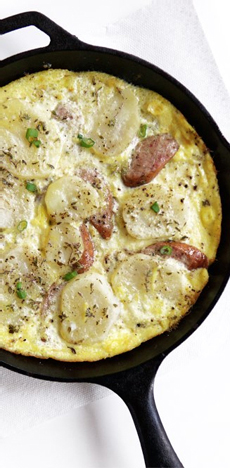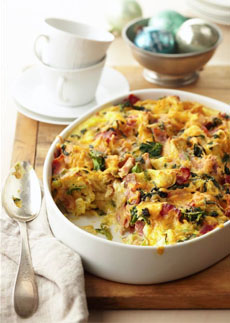TIP OF THE DAY: Different Egg Dishes
 A frittata, made on the stove top and finished in the oven or under the broiler. Photo courtesy Applegate Natural & Organic Meats. |
You can have your breakfast eggs baked in a nest, boiled, fried, poached or scrambled or stuffed.
You can make breakfast burritos and pizzas, Eggs Benedict and a library of other egg dishes. Which brings us to today’s tip: the differences among the egg casserole, frittata, omelet, quiche, strata and torta/tortilla. OMELET The simplest of this group of egg dishes, an omelet consists of beaten eggs mixed with a small amount of cream, milk or water. The mixture is cooked in an omelet pan until set, then folded around a pre-warmed filling (see “inclusions” in the Casserole section), cooked a minute more and served. An omelet pan is important to success. A shallow pan with sloped edges, it can vary in diameter. For those who don’t make omelets enough to develop the technique to flip, there’s a hinged omelet pan. Omelette is the French spelling. It evolved from the earlier amelette and alemelle, literally a thin plate, from the Latin lamella. A casserole is a beaten egg dish with inclusions, that is baked in the oven. “Inclusions” are anything else you want to include in addition to the eggs: bacon, ham or sausage; cheese; herbs; and any number of vegetables, such as asparagus, bell peppers, mushrooms, onions, potatoes, spinach and summer squash. Toss in leftover veggies, too, like carrots, peas and edamame. |
|
|
It is the easiest of these egg dishes to make, since it requires no flipping. Just put the ingredients in a casserole dish and bake until ready. See the photo below. The word origin is French, from casse, a small saucepan, derived from the Medieval Latin cattia, crucible, a metal container for heating substances to high temperatures. A frittata is an Italian-style omelet, often cooked in a large pan to create multiple portions. Like the rest of the egg dishes featured here, it can have a variety of inclusions; some Italian cooks also include leftover pasta. All of the ingredients are cooked at once on the stove top. The frittata is then flipped. (If you don’t like to flip—it takes practice to do it well—then make a casserole.) Unlike an omelet, a frittata is not folded; the inclusions are cooked with the eggs, not a separate filling (see the photo above). The frittata is typically finished in the oven or under the broiler. The result is dense like a crustless quiche, which is cut and served in wedges. It can be eaten hot or cold, as can the strata and torta (the later is often served as tapas). The word comes from the Italian fritto, fried. |
||



